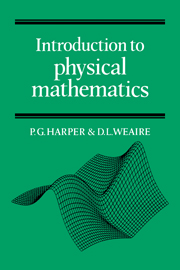Book contents
- Frontmatter
- Contents
- Preface
- Some notes on notation
- 1 Introduction
- 2 Errors
- 3 Cartesian coordinates
- 4 Vectors
- 5 The scalar product
- 6 The vector product and rotation
- 7 Matrices in physics
- 8 The transformation of matrices
- 9 The matrix eigenvalue equation
- 10 Exponential and logarithm functions
- 11 Sine and cosine functions
- 12 Graph plotting and curve sketching
- 13 Differentiation
- 14 Approximations
- 15 Power series and Taylor's expansion
- 16 Partial differentiation
- 17 Integration
- 18 The differential equation
- 19 Solving first-order differential equations
- 20 Second-order differential equations
- 21 Solving second-order differential equations
- 22 The complex exponential
- 23 The circuit equation
- 24 Harmonics and Fourier series
- 25 The diffusion equation
- 26 Waves
- 27 The rate of change of a vector
- 28 The scalar field and gradient operator
- 29 The vector field
- 30 Line integration
- 31 The potential field
- 32 Surface and volume integration
- 33 Flux and divergence
- 34 Circulation and the curl
- 35 Conclusion
- 36 Miscellaneous exercises
- Index
3 - Cartesian coordinates
Published online by Cambridge University Press: 20 October 2009
- Frontmatter
- Contents
- Preface
- Some notes on notation
- 1 Introduction
- 2 Errors
- 3 Cartesian coordinates
- 4 Vectors
- 5 The scalar product
- 6 The vector product and rotation
- 7 Matrices in physics
- 8 The transformation of matrices
- 9 The matrix eigenvalue equation
- 10 Exponential and logarithm functions
- 11 Sine and cosine functions
- 12 Graph plotting and curve sketching
- 13 Differentiation
- 14 Approximations
- 15 Power series and Taylor's expansion
- 16 Partial differentiation
- 17 Integration
- 18 The differential equation
- 19 Solving first-order differential equations
- 20 Second-order differential equations
- 21 Solving second-order differential equations
- 22 The complex exponential
- 23 The circuit equation
- 24 Harmonics and Fourier series
- 25 The diffusion equation
- 26 Waves
- 27 The rate of change of a vector
- 28 The scalar field and gradient operator
- 29 The vector field
- 30 Line integration
- 31 The potential field
- 32 Surface and volume integration
- 33 Flux and divergence
- 34 Circulation and the curl
- 35 Conclusion
- 36 Miscellaneous exercises
- Index
Summary
The non-mathematical New Yorker has no difficulty in locating places – he uses Cartesian coordinates. Numbered streets run east–west and avenues run north–south. If he lives in a city apartment, his floor provides the third coordinate. For the physicist or chemist, atoms in molecules in space are locatable with a similar grid system. Three directions or axes marked out in blocks or length units can provide the unambiguous address of any chosen atom or event. Since the axes, unlike the New York roadways, are fictional, there is some freedom of choice, and this has mathematical consequences. Although any set of axes (mutually perpendicular) will do, if there are other physically significant directions already present, such as the direction of gravity, it generally pays to use them. The house numbers, so to speak, can be counted in either direction so that, having chosen ‘zero’, both positive and negative locations may appear. The use of such coordinates was first introduced by the seventeenth-century French philosopher and scientist René Descartes.
In one dimension (in which we never depart from a straight line), all positions may be measured as displacements (in a chosen direction) from a fixed point, the origin, and are generally denoted by x. So x is continuous and can be positive or negative. Two points x1, x2 have a separation |x2 – x1| (always positive), and the displacement of x2 from x1 is x2 – x1 (may be positive or negative).
- Type
- Chapter
- Information
- Introduction to Physical Mathematics , pp. 17 - 22Publisher: Cambridge University PressPrint publication year: 1985



